Amphibians and Reptiles
by
Christopher Baker
Home : Travel : Costa Rica : CR Handbook : One Article
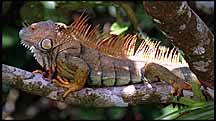 Costa Rica is home to approximately 150 species of amphibians and more
than 200 species of reptiles, half of them snakes. The most common reptile
you'll see is the dragonlike, tree-dwelling green iguana, which seems to have
little fear of man and can grow to two meters in length. You'll spot it often
in moist deciduous habitats, crawling through the forest leaf litter or basking
on branches that hang over water, its preferred route of escape when
threatened. There's no mistaking this reptilian nightmare for any other lizard.
Its head--the size of a man's fist--is crested with a frightening wig of
leathery spines, its heavy body encased in a scaly hide, deeply wrinkled around
the sockets of its muscular legs. Despite its menacing One Million Years
B.C. appearance, it is quite harmless, a nonbelligerent vegetarian. Local
gourmands, for reasons you may not wish to know, call the iguana the "tree
chicken." Its cousin, the ctenosaur (iguana negra) is considered more
edible, and you may see them on sale in mercados of major cities.
Costa Rica is home to approximately 150 species of amphibians and more
than 200 species of reptiles, half of them snakes. The most common reptile
you'll see is the dragonlike, tree-dwelling green iguana, which seems to have
little fear of man and can grow to two meters in length. You'll spot it often
in moist deciduous habitats, crawling through the forest leaf litter or basking
on branches that hang over water, its preferred route of escape when
threatened. There's no mistaking this reptilian nightmare for any other lizard.
Its head--the size of a man's fist--is crested with a frightening wig of
leathery spines, its heavy body encased in a scaly hide, deeply wrinkled around
the sockets of its muscular legs. Despite its menacing One Million Years
B.C. appearance, it is quite harmless, a nonbelligerent vegetarian. Local
gourmands, for reasons you may not wish to know, call the iguana the "tree
chicken." Its cousin, the ctenosaur (iguana negra) is considered more
edible, and you may see them on sale in mercados of major cities.
Another miniature dinosaur is Basilicus basilicus, or Jesus
Christ lizard, a Pacific lowland dweller common in Santa Rosa, Palo Verde, and
Corcovado national parks. These, too, have large crests atop their heads,
backs, and tails, and use water as their means of escape; they run across it on
hind legs! (Hence their name.)
Terrestrial turtles are also common in Costa Rica, particularly in
the Caribbean lowlands, where they can be seen going about their business in
the midmorning hours and after heavy rains. One species--the red turtle, found
in northern Pacific lowlands--is particularly easy to spot: its high-domed
carapace is gaudily patterned in oranges, reds, yellows, and blacks. Several
species of aquatic turtles also frequent the swamps and creeks. Look for them
squatting on partially submerged logs.
The amphibians are primarily represented by the dozens of species
of frogs and toads, most of which you're probably more likely to hear than to
see. That catlike meow? That's Boulenger's hyla (see "Poison-Arrow Frogs,"
below). That sharp tink, tink that is usually the most prominent sound on damp
nights in Costa Rica's midelevation rainforests? That's the tiny tink frog, of
course. That insectlike buzz is probably two bright-red poison-arrow frogs
wrestling belly-to-belly for the sake of a few square feet of turf. And the
deafening choruses of long loud whoops which resound through the night in
Nicoya and the adjacent lowlands of Guanacaste? That's an orgiastic band of
ugly, orange and purple-black Mexican burrowing toads doing their thing. Should
you locate them--the sound carries for miles--don't be surprised to find the
horny toads floating like balloons with legs outstretched, emitting their lusty
whoops. Love's a strange thing!
CROCODILES AND CAIMANS
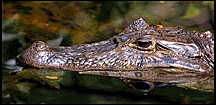 Many travelers visit Costa Rica in the hope of seeing crocodiles and
caimans, modest-sized relatives. One of the smallest of western
crocodilians--no more than two meters long--and possibly the most abundant in
existence today, the speckled caiman is still relatively common in parts of wet
lowland Costa Rica on both the Atlantic and Pacific coasts. Palo Verde and
Tortuguero are both good places to spot them in small creeks, playas, and
brackish mangrove swamps, or basking on the banks of streams and ponds.
Many travelers visit Costa Rica in the hope of seeing crocodiles and
caimans, modest-sized relatives. One of the smallest of western
crocodilians--no more than two meters long--and possibly the most abundant in
existence today, the speckled caiman is still relatively common in parts of wet
lowland Costa Rica on both the Atlantic and Pacific coasts. Palo Verde and
Tortuguero are both good places to spot them in small creeks, playas, and
brackish mangrove swamps, or basking on the banks of streams and ponds.
The scales of the caiman take on the blue-green color of the water
it slithers through. Such camouflage and even the ability to breathe
underwater, through raised nostrils, have not protected the caiman. Their nests
are heavily disturbed by dogs, foxes, tegu lizards, and humans. And
increasingly they are being sought for their skins, which are turned into
trivia. Ironically, this is easing the pressure on the crocodiles, which are
fast disappearing as humanity takes their hides and habitats.
The crocodile exists in precariously low numbers along both coasts,
and the only healthy population is in Corcovado National Park, in the Pacific
southwest. Only three species of crocodiles--the saltwater croc of Southeast
Asia, Africa's Nile crocodile, and the American alligator--are considered
man-killers, but it's still a wise idea to check with locals or park rangers
before swimming in coastal estuaries and lagoons.
For all their beastly behavior, crocodiles are devoted parents. And
despite being relics from the age of the dinosaurs, croc brains are far more
complex than those of other reptiles. Perhaps because crocodiles have ugly
toothy leers and a stigma of primeval wickedness, there isn't the same love of
crocs that has brought international support for the turtles, and their future
is much less secure. As biologist David Janzen says: "We may never again see
the huge four-meter animals that used to terrify the campesinos and eat their
dogs."
POISON-ARROW FROGS
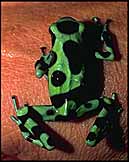 Of all Central America's exotic species none are more
colorful--literally and figuratively--than the "poison-arrow" frogs, of the
type from which Indians extract deadly poisons with which to tip their arrows.
Frogs are tasty little fellows to carnivorous amphibians, reptiles, and birds.
Hence, in many species, the mucous glands common in all amphibians have evolved
to produce a bitter-tasting poison.
Of all Central America's exotic species none are more
colorful--literally and figuratively--than the "poison-arrow" frogs, of the
type from which Indians extract deadly poisons with which to tip their arrows.
Frogs are tasty little fellows to carnivorous amphibians, reptiles, and birds.
Hence, in many species, the mucous glands common in all amphibians have evolved
to produce a bitter-tasting poison.
In Central and South America at least 20 kinds of frogs have
developed this defense still further: their alkaloid poisons are so toxic that
they can paralyze a large bird or small monkey immediately. Several
species--the dendrobatids, or poison-arrow frogs, which are confined to Costa
Rica--produce among the most potent toxins known: atelopidtoxin, bufogenin,
bufotenidine, and bufotoxin. Pity the poor snake that gobbles up Dendrobatis
granuliferus, a tiny, bright green, red, and black frog which inhabits the
lowland forests of the Golfo Dulce region (it is commonly seen on forest floors
of Corcovado National Park). Another species, Bufo marinus, can even
squirt its poison in a fine spray. And some species' eggs and tadpoles even
produce toxins, making them unpalatable, like bad caviar!
Of course, it's no value to an individual frog if its attacker dies
after devouring the victim. Hence, many have developed conspicuous,
striking colors--bright yellow, scarlet, purple, and blue, the colors of poison
recognized throughout the animal world--and sometimes "flash colors" (concealed
when at rest but flashed at appropriate times to startle predators) that
announce, "Beware!" These confident critters don't act like other frogs either.
They're active by day not night, moving boldly around the forest floor,
"confident and secure," says one writer, "in their brilliant livery."
Perhaps the most famous poison frog species is the rare golden
toad, found only in the Monteverde Cloud Forest Reserve. In fact, the
montane rainforest reserve owes its existence in part to the discovery of
Bufo periglenes. This brilliant, neon orange arboreal toad--discovered
in 1964 and so stunning that one biologist harbored "a suspicion that someone
had dipped the examples in enamel paint"--is not easily seen, despite being one
of the most brightly colored animals in the world. The golden toad is so seldom
seen that some naturalists speculate that it may now exist only on the cover of
tourist brochures.
April through May, golden toads go looking for love in the
rainpools of scarlet bromeliads that festoon the high branches. They're easily
distinguished: the males are the orange ones; females are yellow and black with
patches of scarlet. Here, high in the trees, tadpoles of arboreal frogs wriggle
about.
Adaptive Breeding
Few Costa Rican frog species breed in permanent bodies of water, where fish
predation is intense. Above 1,500 meters, where there are no native fish
species, stream breeding is more common (although the introduction in recent
years of trout into upland streams already threatens whole frog populations).
The frogs instead have evolved away from dependence on bodies of
permanent water. Many species, particularly the 39 species of hylids, spend
their entire lives in the tree canopies where they breed in holes and
bromeliads. (The hylas have enlarged suction-cup pads on their toes. They often
catch their prey in midair leaps: the suction discs guarantee surefooted
landings.) Others deposit their eggs on vegetation over streams; the tadpoles
fall when hatched. Others construct frothy foam nests which they float on
pools, dutifully guarded by the watchful male.
Some rainforest species, such as the diminutive and warty
eleutherodactylus--its name is longer than its body--live on the ground, where
they lay their eggs in moist cups of leaves. The tadpole develops fully within
the egg sac before emerging as a perfect, if tiny, replica of its parents: it
and 12 of its siblings could easily fit on a man's fingernail. Some tadpole
species--the Hyla zeteki, for example--are carnivorous: they eat other
frogs' tadpoles. Others, like the smoky frog (Leptodactylus
pentadactylus) are even cannibalistic! This aggressive giant (adults can
grow up to eight inches long) can eat snakes up to 20 inches long. It, too, can
emit a poisonous toxin, to which some snakes are immune. If the smoky frog's
loud hissing, inflated body, and poisonous secretions don't manage to scare off
its predator, it has another ingenious defense: when captured it emits a loud
scream.
SNAKES
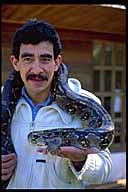 Although rarely seen by the casual tourist in Costa Rica, snakes make up
almost half of all reptile species in the nation (135 species, 17 poisonous).
It is a fortunate traveler indeed who gets to see in the wild the fantastically
elongated, I-beam-shaped chunk-headed snake, with its catlike elliptical
eyes; the slender, beak-nosed bright green vinelike vine snake; or the
relatively benign boa constrictor. Many neotropical snake species inhabit a
wide range of Costa Rican environments, and wherever you are in the country
there are sure to be snakes about. Not that you should worry. Fewer than 500
snakebites are reported each year, and less than three percent of these are
fatal. Most bites occur among farmworkers.
Although rarely seen by the casual tourist in Costa Rica, snakes make up
almost half of all reptile species in the nation (135 species, 17 poisonous).
It is a fortunate traveler indeed who gets to see in the wild the fantastically
elongated, I-beam-shaped chunk-headed snake, with its catlike elliptical
eyes; the slender, beak-nosed bright green vinelike vine snake; or the
relatively benign boa constrictor. Many neotropical snake species inhabit a
wide range of Costa Rican environments, and wherever you are in the country
there are sure to be snakes about. Not that you should worry. Fewer than 500
snakebites are reported each year, and less than three percent of these are
fatal. Most bites occur among farmworkers.
Still, caution is always the watchword. Never reach into holes or
under rocks, debris, or forest-floor leaf litter without first checking with a
stick to see what might be quietly slumbering there. And remember that many
snakes are well-camouflaged arboreal creatures which snooze on branches, so
never reach for a branch without looking. You should even be cautious when
peering inside bromeliads: the dark-colored chunk-headed snake likes to doze
inside the moisture-collecting plants during the dry season.
Among the more common snake species you are likely to see are the
wide-ranging boas which, with luck, you might spot crawling across a
cultivated field or waiting patiently in the bough of a tree in wet or dry
tropical forest, savannah, or dry thorn scrub. Wild boas vary in temperament
and some are aggressive. Though not poisonous, they are quite capable of
inflicting serious damage with their large teeth and will not hesitate to bite.
Heaven forbid a full-grown adult (three meters or more) should sink its teeth
in sufficiently to get its constricting coils around you!
Venomous Snakes
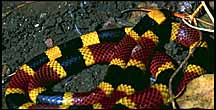 A species of tropical rattlesnake is also found in Guanacaste and a few relic
areas of the Meseta Central. It produces a venom considerably more toxic than
its North American cousin--blindness and suffocation are typical effects on
humans--and it rarely uses its well-developed rattle to warn off the unwary.
A species of tropical rattlesnake is also found in Guanacaste and a few relic
areas of the Meseta Central. It produces a venom considerably more toxic than
its North American cousin--blindness and suffocation are typical effects on
humans--and it rarely uses its well-developed rattle to warn off the unwary.
Among the more colorful snakes are the four species of coral
snakes, with small heads, blunt tails, and bright bands of red, black, and
yellow or white. These highly venomous snakes (often fatal to humans)
exhibit a spectacular defensive display when approached: they flatten their
bodies and snap back and forth while alternately hiding then swinging their
heads side to side and coiling and waving their tails.
Along the Pacific beaches, you may sometimes encounter venomous
pelagic sea snakes, a yellow-bellied and black-backed serpent closely
related to terrestrial cobras and coral snakes. This gregarious snake has
developed an oarlike tail to paddle its way through the ocean. It tends to
drift passively with its buddies among drift-lines of flotsam, where it feeds
on small fish.
The most talked-about snake in Central America is the
fer-de-lance, much feared for its aggressiveness and lethal venom. One
of several Central American pit vipers--another is the bushmaster--the
fer-de-lance can grow to a length of three meters and is abundant throughout
the country, particularly in overgrown fields and rivercourses in drier lowland
regions. Costa Ricans call this lethal creature terciopelo, Spanish for
"velvet." As juveniles, fer-de-lance are arboreal critters that feed on lizards
and frogs, which they attract with a yellow-tipped tail. As adults, they come
down to earth, where they move about at night and, by daylight, rest in loose
coils of burnished brown on the forest floor.
Give the fer-de-lance a wide berth! Unlike other vipers, the
fer-de-lance will bite with little provocation. The snake's powerful venom
dissolves nerve tissue and destroys blood cells and artery walls; those
fortunate enough to survive may suffer paralysis or tissue damage so massive as
to require amputation of the bitten limb.
The Serpentario in San José is a good place to learn
to identify snakes and their habits and habitats (see p. 196). There is also a
snake laboratory at the Clodomiro Picando Institute in Coronado, where you can
watch snakes being milked for venom (see p. 262).
TURTLES
Six of the world's eight species of marine turtles nest on Costa Rica's
beaches, and you can see turtles laying eggs somewhere in Costa Rica virtually
anytime of year. In "season," turtles can vastly outnumber tourists.
Tortuguero National Park, in northeastern Costa Rica, is one of
fewer than 30 places in the world that the green turtle considers clean
enough and safe enough to lay its eggs. Although green turtles were once
abundant throughout the Caribbean, today there are only three important sites
in the region where they nest: one on Aves Island, 62 km west of Montserrat, a
second at Gandoca-Manzanillo (and occasionally on beaches north towards
Cahuita), and another at Tortuguero, the only major nesting site in the western
Caribbean. July through September, more than 5,000 greens swim from their
feeding grounds as far away as the Gulf of Mexico and Venezuela to lay their
eggs at the eons-old nesting site on the oceanside 21-kilometer stretch of
beach on Tortuguero's barrier island.
On the Pacific coast, the most spectacular nestings are at Playa
Nancite, in Santa Rosa National Park, and Ostional Wildlife Refuge, where tens
of thousands of olive Ridley turtles come ashore July-Dec. in
synchronized mass nestings known as arribadas. Giant leatherback
turtles, which can weigh as much as 2,000 pounds and reach a length of
three meters (the largest reptile in the world), nest at Playa Grande, near
Tamarindo, Oct.-March. Hawksbills, ridleys, leatherbacks, Pacific greens and
occasionally loggerheads (primarily Caribbean nesters) can be seen in lesser
numbers at other beaches along the Pacific coast.
Turtle Turmoils
One hundred years ago, green turtles were as numerous as the bison on the North
American plains. They were highly prized for their meat by Central American and
Carib Indians, who netted and harpooned them. And British and Spanish fleets,
buccaneers, and merchantmen counted on turtle meat to feed their crews while
cruising in New World waters. Green turtles are as big as heifers (an average
adult green weighs 250 pounds), easy to catch, and easy to keep alive for weeks
on their backs in a space no bigger than the turtle itself. ("Turtle
turners"
patrolled nesting beaches, where they wrestled female turtles on to
their backs to be picked up next day.)
The end of colonialism offered no respite. Large-scale green turtle
export from Tortuguero, for example, began in 1912 when turtle soup became a
delicacy in Europe. And the recurrent massing of olive ridley turtles at a few
accessible beaches fostered intensive human exploitation. Despite legislation
outlawing the taking of turtle eggs or disturbance of nesting turtles, nest
sites continue to be raided by humans (encouraged by an ancient Mayan legend
that says the eggs are aphrodisiacs).
When not nesting in Costa Rica, Pacific ridleys congregate in
Mexican and Ecuadorian waters, where commercial exploitation continues in
earnest (in 1968, Mexican fishermen harvested over one million turtles for the
leather trade). Turtle oil is used in the manufacture of cosmetics and
perfumes, the shells used in jewelry and ornaments, and the offal dried and
processed as fertilizer. Hawksbills, which rarely exceed 125 pounds, are hunted
illegally for the tourist trade: one occasionally still sees stuffed turtle
specimens for sale.
Mother Nature, too, poses her own challenges. Coatis, dogs,
raccoons, and peccaries dig up nest sites to get at the tasty eggs. Gulls,
vultures, and hungry frigate birds, with their piercing eyes and sharp beaks,
pace the beach hungrily awaiting the hatchlings; crabs lie in wait for the
tardy; and hungry jacks, barracudas, and sharks come close to shore for the
feast. Ridley hatchlings have even been found in the stomachs of leatherback
turtles. Of the hundreds of eggs laid by a female in one season, only a handful
will survive to reach maturity. (As many as 70% of the hatchlings are eaten
before they reach the water.)
Most of the important nesting sites in Costa Rica are now
protected, and access to some is restricted. Still, there is a shortage of
undisturbed beaches where turtles can safely nest. Most turtle populations
continue to decline due to illegal harvesting and environmental pressures,
despite the best efforts of conservationists inspired by Dr. Archie Carr, of
the University of Florida, who has written and lectured indefatigably on behalf
of turtle protection (see "Tortuguero," in the "Caribbean Coast" chapter).
Turtle Ecology
Turtles have hit on a formula for outwitting their predators, though, or
at least for surviving despite them. Each female turtle normally comes ashore
two to six times each season and lays an average of 100 eggs on each occasion.
Some marvelous internal clock arranges for most eggs to hatch at night when
hatchlings can make their frantic rush for the sea concealed by darkness.
Often, baby turtles will emerge from the eggs during the day and wait beneath
the surface of the beach until nightfall. The young hatch together and dig
their way up out through up to a meter of sand as a kind of "simple-minded,
cooperative brotherhood," says Archie Carr, "working mindlessly together to
lower the penalties of being succulent on a hostile shore." They are programmed
to travel fast across the beach to escape the hungry mouths. Even after
reaching the sea they continue to swim frantically for several days--flippers
paddling furiously--like clockwork toys.
No one knows where baby turtles go. They swim off and generally are
not seen again until they appear years later as adults. Turtles are very slow
growing; most immature turtles of all species increase in carapace length by
less than one inch a year. In fact, little is known about the lives of adult
marine turtles. In captivity, a turtle can grow to the size of the smallest
fertile nester in about 10 years; in the wild, they grow much slower.
Turtles are great travelers capable of amazing feats of navigation.
Greens, for example, navigate across up to 1,500 miles of open sea to return,
like salmon, to the same nest site. Guided presumably by stars and currents,
thousands of greens arrive at Tortuguero every year from their faraway feeding
grounds. (Most Tortuguero greens apparently arrive from the Miskito Bank
feeding area of Nicaragua.)
One of the few things known about the intervals between females'
trips to the nesting beaches is that a lot of strenuous romance goes on out in
the surf. There is no pair-bonding between individual turtles, and each female
may be courted by as many as 10 males.
"Sea turtles in love are appallingly industrious," according to
Archie Carr. "The male turtle holds himself in the mating position on top of
the smooth, curved, wet shell of the wave-tossed female by employing a
three-point grappling rig [consisting] of his long, thick, curved, horn-tipped
tail and a heavy, hooked claw on each front flipper . . . The female generally
stays coy and resistant for what seems an unnecessarily long while. Other males
gather, and all strive together over the female in a vast frothy melee." In the
frenzy of mating, intelligence seems sadly lacking. Females have been mounted
by a male who in turn is mounted by another male while several more jealous
males jostle and bite one another to dislodge the successful Casanova.
Most females make their clumsy climb up the beach and lay their
eggs under the cover and cool of darkness (loggerheads and ridleys often nest
in the daytime, as they seem less timid). They normally time their arrival to
coincide with high tide, when they can swim in over the coral reef and when
they do not have to drag themselves puffing and panting across a wide expanse
of beach. Their great weight, unsupported by water, makes breathing difficult.
As a turtle drags her ponderous bulk up the beach, her progress is slow and
punctuated by numerous halts in order to breathe. Some turtles have even been
known to die of heart attacks brought on by the exertions of digging and
laying.
Once she settles on a comfortable spot above the high tide mark,
the female scoops out a large body pit with her front flippers. Then her
amazingly dexterous hind flippers go to work hollowing out a small egg chamber
below her tail and into which white, spongy, golf-ball-size spheres fall every
few seconds. After shoveling the sand back into place and flinging sand wildly
about to hide her precious treasure, she makes her way back to sea.
Note: when near nesting sites, respect the turtles' need for peace and
quiet. Nesting turtles are very timid and extremely sensitive to flashlights,
sudden movements, and noise, which will send a female turtle in hasty retreat
to the sea without laying her eggs. Sometimes in desperation she will drop her
eggs on the sand without digging a proper nest.
The eggs normally take 6-8 weeks to hatch, incubated by the warm
sand. The sex of the hatchling is determined by the temperature of the sand:
males are predominantly produced in cooler sand; a difference of two to three
degrees Celsius will produce females. Thus, hatchlings from any one nest site
are usually siblings of the same gender.
philg@mit.edu
 Many travelers visit Costa Rica in the hope of seeing crocodiles and
caimans, modest-sized relatives. One of the smallest of western
crocodilians--no more than two meters long--and possibly the most abundant in
existence today, the speckled caiman is still relatively common in parts of wet
lowland Costa Rica on both the Atlantic and Pacific coasts. Palo Verde and
Tortuguero are both good places to spot them in small creeks, playas, and
brackish mangrove swamps, or basking on the banks of streams and ponds.
Many travelers visit Costa Rica in the hope of seeing crocodiles and
caimans, modest-sized relatives. One of the smallest of western
crocodilians--no more than two meters long--and possibly the most abundant in
existence today, the speckled caiman is still relatively common in parts of wet
lowland Costa Rica on both the Atlantic and Pacific coasts. Palo Verde and
Tortuguero are both good places to spot them in small creeks, playas, and
brackish mangrove swamps, or basking on the banks of streams and ponds.  Costa Rica is home to approximately 150 species of amphibians and more
than 200 species of reptiles, half of them snakes. The most common reptile
you'll see is the dragonlike, tree-dwelling green iguana, which seems to have
little fear of man and can grow to two meters in length. You'll spot it often
in moist deciduous habitats, crawling through the forest leaf litter or basking
on branches that hang over water, its preferred route of escape when
threatened. There's no mistaking this reptilian nightmare for any other lizard.
Its head--the size of a man's fist--is crested with a frightening wig of
leathery spines, its heavy body encased in a scaly hide, deeply wrinkled around
the sockets of its muscular legs. Despite its menacing One Million Years
B.C. appearance, it is quite harmless, a nonbelligerent vegetarian. Local
gourmands, for reasons you may not wish to know, call the iguana the "tree
chicken." Its cousin, the ctenosaur (iguana negra) is considered more
edible, and you may see them on sale in mercados of major cities.
Costa Rica is home to approximately 150 species of amphibians and more
than 200 species of reptiles, half of them snakes. The most common reptile
you'll see is the dragonlike, tree-dwelling green iguana, which seems to have
little fear of man and can grow to two meters in length. You'll spot it often
in moist deciduous habitats, crawling through the forest leaf litter or basking
on branches that hang over water, its preferred route of escape when
threatened. There's no mistaking this reptilian nightmare for any other lizard.
Its head--the size of a man's fist--is crested with a frightening wig of
leathery spines, its heavy body encased in a scaly hide, deeply wrinkled around
the sockets of its muscular legs. Despite its menacing One Million Years
B.C. appearance, it is quite harmless, a nonbelligerent vegetarian. Local
gourmands, for reasons you may not wish to know, call the iguana the "tree
chicken." Its cousin, the ctenosaur (iguana negra) is considered more
edible, and you may see them on sale in mercados of major cities. 

